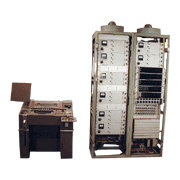In March 1958, NEC finished its first digital computer, the NEAC-1101. This machine used parametrons, invented by Eiichi Goto in 1954, and was perfected by using a single-turn transformer coupling system independently devised by NEC. This computer was designed for scientific and engineering calculations, and was Japan's first computer to use floating point operations. It was capable of decimal 7-digit floating point operations. It used 3,600 parametrons, 29 types of instructions, and had average performance of 3.5ms for addition/subtraction and 8.0ms for multiplication/division. The memory employed ferrite cores (magnetic core matrix system using the 2 ACs with different frequency), and memory capacity was 256 words (32-digit configuration). The NEAC-1101 was enhanced via improvements like expanding the memory capacity to 512 words, and was used for about 8 years for scientific and engineering calculations at NEC's research laboratory. The results from developing this computer contributed greatly to the development of subsequent parametron computers at NEC.
| NEAC-1101 | |
|---|---|
| Completion date |
March 1958 |
| Control system | Stored program system |
| External numeric words |
Decimal 7-digit, Characteristic ±8 |
| Internal numeric words | Binary (Long word) 32 digits (bits) Mantissa: 25 digits + sign Characteristic: 5 digits (Short word) 16 digits |
| Commands (Instructions) | 1 address system, 29 types |
| Arithmetic system | Parallel, floating point |
| Operation speed | Addition/Subtraction: Average 3.5ms Multiplication/Division: Average 8.0ms |
| Arithmetic element |
Parametron (3,600 elements) Drive frequency: 2MHz off-and-on frequency: 19.5kHz |
| Memory element | Ferrite core Outer diameter 2mm, inner diameter 1mm, thickness 0.6mm Magnetic core matrix system using 2 ACs with different frequency Capacity: 256 words |
| Input/Output devices | Paper tape reader 600 char/min Paper tape punch 600 char/min Typewriter 400char/min |


